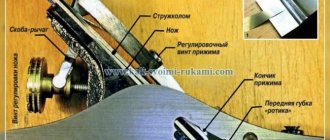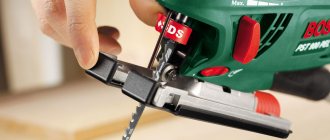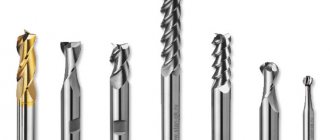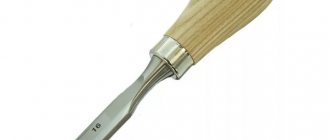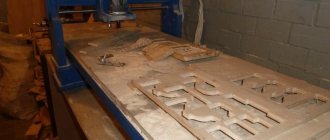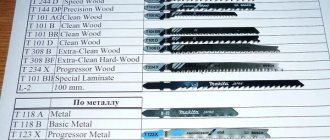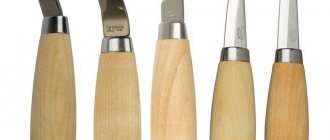This is something for the soul and it must bring satisfaction and a feeling of peace. The right type of plane will help you with this. This is a carpentry tool that is used for planing wood.
Its main purpose is to give the desired shape to the surfaces of wooden elements, eliminate roughness, chamfer and adjust parts to the desired size.
Photo of mini drill
Types of hand planes
Planes are also classified according to the type of wood processing: flat or figured.
For flat processing:
- simple single plane. The design has one straight blade and a sole with rounded edges, for high-quality processing without visible marks. This is one of the universal planes, used for leveling and finishing workpieces;
- A miter plane is a small tool with a sole rounded at the ends. From the name it is clear that it is used for processing ends. Also used in final sanding of wood. Basically, it comes complete with a chipbreaker. There are models with a straight or oblique knife;
- A jointer is a popular type of woodworking tool. Has an elongated body. Used for leveling edges and planes. Allows you to process products with a large area. High-quality leveling is carried out using a sharp knife. In the process of processing a product, first there are abrupt chips. If a continuous strip begins to emerge, it means that the surface of the part is completely leveled;
- semi-jointer. Smaller in size than a jointer. Used for processing small parts;
- Sherhebel has a narrow sole and a rounded blade. The iron is installed at an angle of 45 degrees to the body. During the work, it removes a thick layer of wood. It is usually used for initial rough processing, since roughness remains on the surface during the process;
- A double knife planer (or grinder) consists of a double knife with a chip breaker. The blade is at an angle of 50 degrees to the sole. Used in fine finishing to achieve a smooth surface;
- roughing planes are a tool for finishing the edges of drywall. The sole looks like a grater and is made of hardened steel. The body is made of reinforced plastic, steel or silumin;
- The tsinubel has a serrated blade that creates a grooved surface in the process. This treatment is the best option for gluing the material, as it gives better adhesion of the parts. Often used when planing hard wood.
- zenzubel - a plane with a narrow block on which a blade in the shape of a spatula is attached. The iron comes with a straight or oblique end. When processed along and across the fibers, a smooth surface is obtained. Using this tool you can create folds, grooves, rectangular cuts, and also trim quarters;
- Kantenhobel is distinguished by an interesting shape of the edge of the blade - in the form of a trapezoid. Some models have two knives. Performs the following functions: processes edges, ends, and easily copes with chamfering. Can process wood, plastic, drywall;
- The tongue and groove pile consists of several plates connected to each other by bolts. The blade is attached to one block, the other is a guide. Using a tongue and groove, you can easily create a good longitudinal groove of different depths. The design has a stop that can be adjusted depending on the required distance from the edge of the groove to the edge;
- federgubel - a special plow with a special blade, with a slot in the middle. Using it, a longitudinal protrusion is made along the edge of the workpiece;
- The kalevka has several soles and a replaceable blade with a figured end. Used for decorative processing of photo frames, cornices and other wooden products;
- The folding belt has a wide stepped body. It does an excellent job of removing grooves and stripping quarters. Since the body is wide, you can create identical grooves without marking. When processing a quarter vertically, a side cutter is installed;
- staple It is used to make rounded edges. The blade and body have a concave, rounded shape;
- humpback - a plane with a semicircular sole, can be concave or convex. A sharp knife is attached to the center of the body. The sole can be metal or wood. On some models it is possible to change the degree of body bending. Due to this, the part can be made either concave or curved;
- the fillet resembles a humpback fish in appearance and also has a convex sole. It is used to make semicircular recesses and recesses. Available in different pad widths. This determines what kind of notch you get;
- Small planes are used in small jobs: inlays, restorations, for removing small chamfers, when correcting minor errors. Typically, professional carpenters work with this tool, since beginners often make mistakes or simply cannot cope with the equipment.
milling cutter
Rating of high-quality models with a metal body
BISON Professional No. 3 210x55 mm
A high-quality, reliable model produced by a popular brand, which is intended for household and professional use. This device can be actively used both when carrying out carpentry and when performing a variety of carpentry work. Thanks to the use of this model, a high level of quality of processed surfaces is ensured. It is characterized by a long period of operation, simplicity, and ease of use.
Equipped with ergonomic handles that provide a high level of safety when processing wooden surfaces. In the manufacture of the body of this model, cast iron was used. The cutting blade is made of high quality U8A steel, which has undergone a hardening procedure. The width of the knife is 45 mm. The dimensions of the sole are 210x55 mm. Weight - 1075 grams.
BISON Professional No. 3 210x55 mm
Advantages:
- Quality of materials;
- Reliable case;
- Ergonomic handle;
- Easy to adjust planing depth;
- High-quality knife blade (good sharpening).
Flaws:
- High price (1680 rubles);
- Some users indicate that the knife needs some fine-tuning;
- A bit heavy.
STANLEY 60 ½ 1-12-060
A high-quality device for processing the ends of workpieces, which is produced under a popular, well-known brand. Allows you to process even hard wood with high quality. High accuracy of adjustment of the cutting element is ensured by a special mechanism that allows you to set the work table in the desired position.
High-quality metal was used in the manufacture of the case, as well as the working components of this model. The handles have a high level of ergonomics and provide a comfortable, tenacious grip. The width of the knife is 35 mm, while its installation angle is 13 degrees. Sole length – 150 mm.
STANLEY 60 ½ 1-12-060
Advantages:
- Durable housing;
- Reliable design;
- High quality material;
- Convenient to use;
- Durability.
Flaws:
- According to some users, this model has slight irregularities in the geometry of the case;
- Cost (2328 rubles).
BISON Expert Metal semi-jointer 18505-35_z01
It is a reliable device that is specially designed for planing wooden surfaces, performing a variety of carpentry, as well as all kinds of carpentry tasks. High-quality tool steel was used in the manufacture of knives. It is worth noting that the knives have been hardened, which ensures a long period of their operation.
This model is equipped with a cast iron body. Supports adjustment of knives in two planes. Equipped with ergonomic, comfortable handles. Used for finishing planing. Knife width – 50 mm. Sole length – 350 mm.
BISON Expert Metal semi-jointer 18505-35_z01
Advantages:
- Good knife sharpening;
- Hard wood can be processed;
- Good ergonomics of the handles;
- Possibility of universal use.
Flaws:
- Price (3009 rubles);
- No frog;
- Some users indicate that when performing work, the handle can rotate, which creates some inconvenience and discomfort.
Sparta 210795 black 245x58 mm
It is an inexpensive, reliable planer that is perfect for processing small workpieces. Copes with removing excess wood layer and obtaining smooth surfaces in hard-to-reach areas of the workpiece. It is equipped with a high-quality cast iron body, which is distinguished by a durable, well-thought-out design that is not subject to deformation.
High-speed steel was used in the manufacture of the knife. The design of this device is equipped with a mechanism that allows automatic centering of the knife being used. It is additionally equipped with a chipbreaker, which allows for final processing of products.
Sparta 210795 black 245x58 mm
Advantages:
- Price (850 rubles);
- Dimensions;
- Case quality.
Flaws:
- Rough processing of the sole;
- There is a slight play on the lever;
- Low quality of components;
- Suitable as a budget option for home use, rough processing of various products.
Selection of electric planes
The main list of operations performed by an electrical appliance includes: preliminary surface treatment (planing), processing to size, fitting, edge processing. In addition, the presence of additional accessories also expands the list of functions of the electric planer.
In the process of choosing the model you need, we pay close attention to the following points:
- sole. Just like with a mechanical plane, a level sole will ensure that you get evenly planed wood. This is the basics. When choosing a model, give preference to soles with grooves; they are more comfortable to use. The stability of the tool directly depends on the thickness and length of this element;
- handles. An electric planer is not the lightest or most maneuverable tool, so in all cases it is easier to move it across the board area with the help of two handles. If you apply more force while pressing on the front, the chips will be noticeably thicker;
- knives. Removable knives of modern models of power tools are double-sided. Different manufacturers may use hardened steel, tungsten and carbide as materials. Depending on the material, the knives should be carefully aligned with each other.
- protective devices. All existing models from different manufacturers are equally carefully equipped with protective devices. We remember that this is a traumatic instrument. In the electric version of the tool, contact of fingers with knives is excluded;
- additional equipment. You can purchase the necessary parts for the basic model. For example, knives for roughing wood.
Principle of operation
The front part of the sole moves along the raw surface, and it can be adjusted in height, determining the depth of cut and the size of the chips. The rear part, therefore, moves along the planed board. You can easily adjust the cutting depth. Do not forget, when working with this tool, to move it smoothly at the same speed; the indicator of correct operation will be the identical chips that you remove from the wooden part.
Hand plane selection options
The design of a hand tool is simple, but problems arise when purchasing.
Let's figure out how to choose a plane yourself:
The first step is to decide on the material you will work with. For our category of tools, this is either classic wood, or drywall and similar materials.
There are two types of devices for working with gypsum boards:
- roughing
– for adjusting the edges of sheets; - edge
- for forming chamfers.
At home, for small volumes of work, instead of both types, you can get by with a hand cutter, but for production it is better to purchase a specialized model.
To select a tool for wood, it is worth finding out what types of planes are available for working on this material.
When leveling a surface, in most cases, 3 types of tools are used:
- sherhebel - a large mechanical one for primary processing, removes thick chips;
- after primary planing, the surface is processed with a single plane having one blade;
- final processing is carried out with a double plane, in addition to the main knife, which has a chip breaker.
These three types of tools do not replace each other, but complement each other. In a home workshop, it's nice to have everything.
For precision finishing of large surfaces, a type called a jointer is used. It is necessarily equipped with a chip breaker, and its length exceeds the size of a conventional model by 2–3 times.
Our review also mentions a model of a cross-cut plane - it is designed for planing the ends of workpieces.
There are also a large number of models for figure cutting (humpback, zenzubel, groove, etc.), but today they are practically replaced by power tools.
Regarding workmanship, when purchasing any model you should pay attention to the sole. It should be even and smooth
Also evaluate the quality and sharpening of the knife, but it is not difficult to re-sharpen it or even replace it.
It is rational to make a choice based on the manufacturer. Our review included models from the following brands: ZUBR, matrix, Sparta, STANLEY, STAYER, MTX.
The cost of a tool in most cases directly determines its consumer properties. High-quality materials are not cheap. Also included in the final price is the depreciation of the good equipment on which the plane was produced and the wages of a skilled worker.
How to sharpen a blade edge
To work in accordance with the operating rules, it is necessary to use a tool with a well-sharpened blade. You can sharpen the knife yourself using a mandrel with a side clamp and a support roller.
The desired angle is set, after which the blade is pulled along the abrasive stone (800). Initially, efforts are directed to the left edge of the tip. After eight passes, repeat stripping, applying pressure to the right side of the blade. Next, the force is applied to the central part of the knife. In this case, 4 passes through the abrasive are sufficient.
The simplest device for sharpening planer knives and chisels.
After obtaining the desired profile, the blade is sharpened on an 8000 stone. This operation is necessary to polish the sharpening surface. The sequence of pressure direction is the same as when passing through a coarse abrasive.
The process is completed by removing burrs from the back of the cutter. To do this, use an 8000 stone in combination with a ruler.
How to smooth and polish the back of a blade
The back side of the cutter should be flat after sharpening. This ensures a half sharp and smooth cutting edge. The smooth surface promotes better fit of the chipbreaker. In this case, after sharpening, leveling and polishing are required. The process is performed using a ruler and an 8000 stone.
- Create a slurry on the surface of the abrasive stone using a nagura stone.
- Place a ruler on the right edge of the stone (thickness 0.5 mm, length about 15 cm).
- Move the ruler over the stone 2-3 times to feel the sticking effect.
- Lay the blade across the stone, so that the edge hangs (up to 6 mm) from the left edge, and the middle remains on the ruler.
- Apply light pressure with 3 fingers to the area behind the edge to be sanded. Pull the blade back up to 12 mm from the edge of the abrasive. You will need to repeat the broaching 12-15 times. As a result, a strip appears near the cutting edge. A one-degree chamfer does not affect the quality of planing, but saves time and effort in the process of processing wooden workpieces.
Types and purpose of engravers
In appearance, the tool resembles a straight grinder, the main elements of which are: motor, gearbox, shaft, housing. Operating principle: pressing the start button starts the electric motor, rotational movements are transmitted through the gearbox to the spindle, which sets the working equipment in motion.
Engravers are:
- electrical - they operate from a fixed network;
- rechargeable - lithium-ion batteries are used as a power source;
- with a flexible shaft - a hose of different lengths with a steel cable inside, which is mounted between the equipment and the spindle. It acts as an extension cord and makes work more comfortable. The tool can be held with one hand, like a regular pencil, and applied to the surface with patterns, inscriptions, and decorative processing;
- laser - desktop, floor-standing electric machines, which can be solid-state (allow you to process metal) and gas (used to work with any materials, including genuine leather, glass).
Proper use of the engraver
- allocation of free space on the countertop;
- installation of a powerful lamp to illuminate small parts;
- covering the surface with cloth or thick paper, because during the cutting process chips and dust are formed;
- preparation of carpenter's tape, felt-tip pen, pencil for transferring the drawing. Sticky paper tape will allow you to attach the sketch to the surface; after removing it, there will be no streaks left.
Important! Before applying the pattern, the metal, plastic, glass surface must be treated with alcohol or solvent. The pattern is applied to the wood with a pencil.
- preparation of working equipment - the instructions for the model describe the purpose of each of them and the possibility of processing a particular material;
- Installing a suspension allows you to minimize vibration and cutting errors. It should not interfere with the flexible shaft;
- Beginners are recommended to choose the minimum number of revolutions - they will be able to get a neat and clear pattern, lines of the same depth;
- the drawing is first outlined along the contour, after which small elements are drawn;
- At the final stage, the pattern is polished with a soft felt nozzle, which allows you to remove all irregularities from the surface.
- before connecting to the network, the network cable is checked for integrity;
- To protect the eyes from dust and sparks, use special glasses;
- If the nozzle is jammed, it is prohibited to pull it out until the device is disconnected from the electrical network or the battery is disconnected;
- If the plastic case is very hot, the device should be allowed to rest for some time. Due to the lack of an air cooling system, this must be done frequently. This will prevent overheating of the motor and failure of the engraver. The optimal operating and cooling times are indicated in the instructions;
- When purchasing additional consumables, you should make sure that they fit the characteristics of the model.
Daily care
Carefully clean the ventilation holes on the housing, as air flows through them to cool the engine. When cutting or grinding products made of PVC, glass or wood, the holes become littered with particles of debris and dust, which negatively affects the productivity of the engraver and leads to its premature failure. Cleaning should be done with a dry soft cloth. By following these simple rules, you will be able to use the tool for a long time and get high-quality work results.
More about the electric planer
Definition
An electric planer is a woodworking tool that operates using electrical energy. Unlike a traditional plane, which has a blade at the bottom that removes a layer of wood if you press the tool on the workpiece and move it away from you, an electric plane cuts the material due to a drum with blades rotating in a certain direction.
Varieties
There are several types of electric planers.
Depending on the possibility of movement, they are of two types:
When working with this type of tools, they are held in the hands and their movement is also directed with the hands.
They are a metal table with an electric motor and one or more drums with blades attached to it. In addition to them, such a table usually has adjustable guides for more precise movement of the workpiece. The plane itself does not move during operation – the workpiece being processed is moved.
1-Hand plane 2-Stationary plane
Depending on the type of power supply, electric planers are divided into:
They operate from a 220 V household power supply.
They are powered by replaceable batteries.
1-Network plane 2-Battery plane
Expert opinion Kuznetsov Vasily Stepanovich
In the case of an electric planer, it is better to choose a network one. The fact is that this tool requires quite a lot of electricity, which leads to rapid battery drain. Of course, a cordless tool is somewhat autonomous and can be taken anywhere, but its operating time on one battery will be only one to two hours, which is very short.
Structural device
The manual electric planer consists of the following parts:
- The case is a casing (most often plastic) designed to protect tool parts from mechanical damage.
- A handle is an element for holding the tool in your hands while working (as a rule, electric planers have two handles - for the right and left hands).
- Control button - turns on the power supply to the engine.
- Rotation speed regulator - is a variable resistor that allows you to select the desired rotation speed of the drum with blades.
- Electric motor - located inside the housing and drives the drum with blades.
- Belt drive is a belt made of polymer material that transmits rotational energy from the electric motor to the drum.
- A drum is a cylindrical piece of metal with blades attached to it, which perform the function of processing wood.
- Lower platform. It is a flat metal plate with a cutout for the drum and acts as a guide, which allows you to smoothly process the wood, and also balances the center of gravity of the tool, moving it to the lower part of the plane.
- Channel for removing chips. A special channel for removing chips is usually placed next to the drums. When working with an electric planer, quite a lot of them are formed, so if you do not remove them, they can clog the drum or the inside of the tool body.
The design of a stationary electric planer is somewhat different.
It consists of:
- Metal table.
- Electric motor.
- Belt drive.
- One or more drums with blades.
- A guide that ensures the movement of the workpiece in the desired direction.
How to make a plane with your own hands
By the way, it is not difficult to assemble a wood plane even with your own hands, and therefore most craftsmen prefer not to mess with factory-made models and immediately make the tool for themselves. The tool knife and chip breaker should be purchased at a hardware store, but in order for the quality of the cut to be high, you will need tool steel, which is not so easy to find in a garage or household. In the design of the tool, the knife is a consumable, and therefore its cost will be affordable for every person.
Please note that first you should buy a blade, and then, based on its width, you can start making the plane itself.
The tool is cut out from a solid block, onto which markings should be applied in advance - oblique and vertical lines. Next, you should drill the center of the workpiece and form four holes in the corners. Saw off two cheeks from a solid block, and the workpiece itself should be cut at an angle into two uneven parts. After the cheeks need to be glued to the base elements, and when the glue dries, the sole should be glued to the bottom of the structure. Insert a metal rod into the hole in the cheeks, which will act as a support when clamping the blade with a wedge. This is how you get the simplest DIY plane. All that remains is to sand the surfaces, set the knife at the required angle and you can start working.
How to choose?
Woodworkers often wonder which plane is best to choose for use at home and at work.
When purchasing a tool, you should pay attention to the following features
- Sole. It should be characterized by evenness, absence of damage, chips, or changes.
- The blade in the plane must be properly fixed, and there should be no play. The best material for making the element is considered to be hardened steel. The edges must not be damaged during sharpening.
- Lever. It needs to be selected according to your palm. The master should be comfortable working with a plane. You should not buy a high-quality tool that is inconvenient to use.
- Manufacturer. According to experts, planes that were made back in Soviet times are considered the best, as they are characterized by high quality workmanship and good knife characteristics. Such modern brands of planes as Stanley, Sigma, Zubr, Irwin, Sparta, Bailey, Handyman have proven themselves well. According to consumer reviews, you should not give preference to the Indian tool manufacturer Groz, as it may be inconvenient and of poor quality.
- Case material. It is up to the master to decide whether to choose metal or wood. Often consumers choose wooden planes, but they are not so easy to find.
A hand plane is a fairly popular tool today, which is why many manufacturers produce it. This device may have different purposes, quality, and functionality. Before buying a plane, you should decide on the purpose of the purchase, as well as the functions that the tool will need to perform.
An overview of the Enkor RE-780/82 electric planer is presented in the following video.
Review of high-quality models with a wooden body
Wooden folding belt PremiumPlus 30mm PINIE, 10-30 PremiuPlus
It is, in the opinion of buyers, a high-quality hand tool that is used for processing and planing a variety of workpieces. Beech was used to make the body of this product. The sole of this model is made of hornbeam. In addition, this device is equipped with a chip breaker. Thanks to a special mechanism, the user can adjust the front sole.
This model is equipped with one knife, which is made of high quality steel. The sole length is 255 mm. The width of the blade, which is located at an angle of 35 degrees, is 30 mm. The weight of the product is 0.55 kg. General dimensions – 260x150x35 mm.
Wooden folding belt PremiumPlus 30mm PINIE, 10-30 PremiuPlus
Advantages:
- Provides a narrow plow (perfectly makes paths and half-paths);
- Reliable case;
- Movable sole;
- High quality blade;
- Easy to set up.
Flaws:
- High price (average cost 6197 rubles).
SIBIN 18540
A classic, budget, inexpensive model of a wood plane. Equipped with one replaceable blade, the width of which is 47 mm. Perfect for home use and wood processing. Equipped with a durable left hand rest. Thanks to the high-quality body and the width of the cutting part used, it ensures fast processing of a variety of workpieces. The dimensions of the sole are 240x60 mm.
SIBIN 18540
Advantages:
- Low price (611 rubles);
- Easy to set up;
- Ergonomic body;
- Possibility of adjusting the planing depth;
- Processing quality.
Flaws:
- Some users claim that the knife should be sharpened immediately after purchasing this product.
STAYER MASTER 1854-24_z01
It is a simple, ordinary, inexpensive, household wooden hand plane, which is perfect for performing simple tasks and finishing a variety of workpieces. This model can be used in cases where it is necessary to plan the end of any parts of various products (window frames, boxes, and so on).
The cutting part of this device is made of high-quality, hardened steel. Hard wood was used to make the sole. The blade width is 52 mm. The length of the sole is 240 mm.
STAYER MASTER 1854-24_z01
Advantages:
- Price (443 rubles);
- Ease of use;
- Blade quality;
- Easy to adjust planing depth.
Flaws:
- Not suitable for complex tasks (best purchased for infrequent, occasional home use).
ROS, wooden, single blade (240x65 mm)
An inexpensive device from the budget segment, which is perfect for household use and processing of wooden workpieces. In the manufacture of the handle, as well as the body of this device, hard wood was used. This model is an excellent solution for home use and roughing and finishing of a variety of wooden surfaces. The knife width is 55 mm, the sole is 65 mm. Country of origin: Russia.
ROS, wooden, single blade (240x65 mm)
Advantages:
- Low cost (573 rubles);
- Ease of use and setup;
- Reliable case;
- Made from environmentally friendly material.
Flaws:
- Not suitable for complex tasks.
Figure planing
Planes classified in this category are designed for processing grooves, protrusions, and edges.
Zenzubeli
With their help, quarters are selected and cleaned, rectangular cuts, grooves, and folds are formed, and perpendicular elements of the workpieces are planed. The zenzubel cutter is made in the form of a blade with a straight or oblique cutting edge, it depends on how the knife is secured relative to the sole. The oblique blade has two cutting edges; they are sharpened on both sides. Zenzubels are used where it is necessary to form a dovetail groove. Even processing across the grain gives a perfectly smooth surface.
It is better to start selecting a quarter with a folding tool, and use a zenzubel for finishing work.
Kantenhobeli
This is an edge selector used for chamfering, processing ends, edges, and bringing to specified dimensions.
The main difference between the kantenhobel and other planes is the trapezoidal shape of the blade.
Some models may be equipped with two cutting elements. Depending on the position of the knife, you can make a cut along the edge at an angle. In this case, a fold is formed for future joining of two parts, and gaps are eliminated.
Tongue and pile piles
With their help, a longitudinal groove is selected. The groove consists of two blocks connected to each other with screws. One of them serves as a guide, the second serves as a mount for the blade. Using an adjustable stop, the edge of the groove can be set at the desired distance from the edge. Thanks to the persistent protrusion, the penetration occurs to the required parameters, while the blade does not bend.
Federgubeli
A shaped end plane is designed to form a longitudinal protrusion along the edge of the workpiece. This is ensured by a blade having an opening in the center. After passing along the edge, a ridge remains. It fits into the groove. As a result, two parts are connected.
Kalevki
Equipped with a replaceable blade with a shaped cutting edge. They have a multi-stage sole. The tool is most often used for the manufacture of decorative parts: cornices, baguettes, and other wooden elements.
Falzgebeli
Necessary for selecting a groove along the edge of the workpiece without preliminary marking. Includes multi-stage sole. A wide block helps to form grooves of equal size. If it is necessary to process the vertical wall of the quarter, an additional side cutter is installed on the rebate.
Staples
Designed for rounding edges of parts. These planes have a blade whose edge is equipped with a semicircular recess. There is a concave sole. When processing the edges of the rectangular ends of parts, the knife removes chips in such a way that the edge acquires a rounded shape.
Durable mini planer MTX 879055 for drywall
The mini-plane for processing the edges of plasterboard sheets is designed and manufactured in Germany. The body is made of reinforced nylon, which allows us to achieve a combination of mechanical strength with low weight - 277 g.
The two trapezoidal cutting blades are made from 45 carbon tool steel, which is strong but not prone to brittleness. One blade is set to cut at an angle of 45 degrees, the other - 22.5. Their depth can be adjusted separately.
Settings are available for plasterboard thicknesses of 9.5 mm, 12.5 mm and for thicker sheets 15+ mm. The transverse position of the web is also adjustable. The handle is made in the form of a bead on the body.
Recommended for creating edges and bevels on sheets of plasterboard, wood and laminated plastic. Suitable for both experienced and novice production workers.
The owners note the traditional German quality of the instrument and the thoughtfulness of the design. Many people believe that a length of 25 cm is optimal. A shorter model will require a lot of time to work, and an extended one is not always convenient.
Assembling the plane and adjusting the position of the frog
Before you begin assembling the planer parts, you need to inspect the metal elements. It is recommended to treat unpainted areas with oil to prevent rust formation.
Design and setup of a hand plane
Build process:
- Move to the side the screw stop plate responsible for the longitudinal adjustment. This will allow the frog to take its place in the center of the body.
- Lightly tighten the frog clamping screws. Thanks to this, it will move back and forth using the adjustment screw.
- To determine the correct position of the frog, you need to install the blade and adjust it for thin, uniform chips. Stretch the wooden piece along the sole, directing it across the blade. The edge of the knife should run parallel to the leading edge of the mouth. If asymmetry is observed, you need to slightly move the frog without touching the knife skew lever. Thus, parallelism is achieved.
- For beginning craftsmen, the gap is set within 0.4-0.5 mm. Experienced carpenters will be able to adjust the gap to 0.15 mm.
- After setting the parallelism and gap, remove the knife without touching the frog. Tighten the clamping screws without using excessive force. Otherwise, the thin section of the sole in the mouth area may crack. Tightening is necessary only to fix the position of the frog.
- Before work, all screws are tightened and the knife is installed. Unfair preparation of the tool will provoke deformation of the sole under the influence of the lever-clamping insert.
- Lastly, the screw of the lever-clamping insert is adjusted. He takes a position so that under the force of his thumb a clear fixation of the lever is felt. A loose fit in the threaded hole provokes the formation of backlash. To seal the element, it is recommended to unscrew the screw, degrease it, drop a liquid fixative into the threaded hole, return the screw to its original place, making the same number of turns as it took to unscrew.
The best professional electric planers
Professional means more powerful. But not only in terms of performance and capabilities, but also in terms of electricity consumption. Therefore, professional models of electric planers are most often purchased by representatives of small and medium-sized businesses. An expensive instrument should be the “breadwinner”. The best electric planers have excellent functionality and excellent quality. These include the following models.
Makita KP312S
The considerable size and impressive weight of the Makita KP312S do not prevent it from being highly productive and easy to use. A powerful 2200W motor spins the drum at a speed of 12 thousand revolutions per minute. A sharp rotary knife removes 15 centimeters of the width of the product in one pass. It can be submerged by 3.5 mm. If the specified width is 312 mm, then the cut thickness will be 1.5 mm. The planing depth can be adjusted directly during the process.
The smart electronic filling of the plane will qualitatively balance all operations. It is especially valuable that the tireless assistant is able to work non-stop and produce significant quantities of processed material. Electronic motor braking stops the knife instantly. This not only increases safety, but saves working time.
Advantages
- Easy replacement of cutting parts;
- Effective dust removal system;
- Guide roller;
- Ergonomic handles;
- Uniquely durable body;
- Cable length 10 meters.
Flaws
Weight 19 kg.
Double insulation is made in compliance with European standards. The Makita KP312S electric planer can be connected even to ungrounded outlets.
Mafell MHU82 T-MAX set
Mafell specializes in the production of small series electrical carpentry equipment. Each product, including the Mafell MHU82 T-MAX set planer, is manufactured with the latest technology. At first glance, the model does not have much power, only 800W. Standard planing width 82 mm, depth 3 mm, 12000 drum revolutions.
But it has its own highlights. Thus, Mafell MHU82 T-MAX set has a universal motor and a built-in pipe for removing chips. This makes the plane especially convenient for folding doors, shaping parts and cutting out quarters. After processing the wood and materials, the surface is smooth, like a mirror. There is a possibility of permanent fastening.
Advantages
- Quarter sampling depth 22 mm;
- Sole material: cast aluminum;
- Pendulum protective casing;
- Switch lock button;
- Convenient adapter for a vacuum cleaner;
- Weight 3.4 kg.
Flaws
- The speed is not regulated;
- There is no soft start or overload protection.
Minor shortcomings of the model are compensated for by a price that is half that of its analogues.
What is the difference between a jointer and a planer?
The main difference between a jointer and a plane is the number of blades: a plane has one, and a jointer has two. The structure of the jointer itself is not much different from the planer, but its body is much longer. Thanks to this, using a jointer you can process a much larger area in less time than with a planer.
According to the existing classification, carpentry tools for wood processing are conventionally divided into:
- flat planes;
- figure planers
